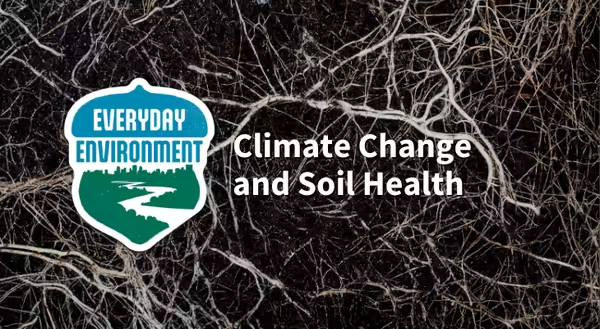
Soil is more than just dirt; it is a vital component of our ecosystem. It provides nutrients for plants, supports biodiversity, and plays a crucial role in water filtration and carbon storage. Healthy soil is resilient and can better withstand environmental stresses, making it a key player in our adaptation to our changing climate.
Threats to soil health
Threats to soil health vary across different regions. As soil supports physical and economic systems across Illinois, degradation of this vital resource can cause devastating effects on Illinois communities. Our primary concern is erosion, or the removal of topsoil from the land surface through wind, water, or tillage. This loss of topsoil also causes the loss of nutrient-rich particles that feed our plants. Many factors influence a soil’s erosivity, or R-Factor, including how old the soil is, its carbon content, and its plant cover.
Promoting soil health
There are a few practices to help keep soils in place. The first is to cover the soil. In practice, this looks like cover cropping or implementing perennial systems that constantly keep the soil in place. Covering bare soil with plants prevents damage from rain and drought, so the physical removal of the top layer does not occur. Not only does land cover physically protect the soil from pelting rain and drying of the soil, but these practices also build long-term resilience of those soils through carbon storage or sequestration.
Carbon sequestration
Carbon sequestration involves capturing and storing atmospheric carbon dioxide in the soil. It’s an appealing concept that can add economic value for farmers and assist our long-term fight against climate change, but it’s more complex than soil simply storing carbon. Our current agriculture system typically operates on an annual cropping system — plant seeds, grow plants, harvest plants, repeat. While those plants are taking carbon from the atmosphere and storing it in their cells, that carbon doesn’t get to the soil until that plant material decomposes. So that carbon rich plant material must be returned to the soil through decomposition if it is going to store carbon. That can be done through a few practices: cover cropping and perennial cropping systems. If at least some of that plant material is returned to the soil, carbon is stored.
Sequester carbon for climate change or general environmental health
The challenge with carbon sequestration is in its calculation and in its permanence. Measuring and ensuring the long-term storage of carbon is complex. Maintaining the storage poses many questions, with a large one being how long is appropriate to be considered value added in combatting climate change? How long should a farmer keep that carbon in the soil for it to be considered mitigating climate change? And do practices such as tilling, a major cause of soil carbon loss, cancel that effect?
There are many challenges to carbon sequestration as a tactic for climate change, however, as a tactic for addressing environmental challenges and general soil health, it is extremely valuable. Adding carbon to soil improves soil adaptability to the climate impacts of drought and heavy rainfall, it improves water quality through reduced runoff and improved water filtration, and it leads to the development of healthier root systems.
Addressing soil health for all
Soil health is not just for farmers; it’s for anyone who wants to build a healthier, more resilient landscape. To promote soil health in your community, think about these tips:
- Land cover is key: Consider the permanence and character of your cover. Find cover that is going to be there a long time and support a healthy ecosystem. Consider Illinois native species that support local pollinator populations.
- Understand your soil: If you are managing a soil yourself, diagnose a problem through research or by reaching out to your local Extension office to understand best ways to address any issues. Often our first inclination is to fertilize a yellowing lawn, when in reality other issues like soil compaction or flooding might be a plausible cause with different solutions.
- Spread the word: Talk to your friends, neighbors, and community about the value of soil in building resiliency. It is the basis for life that supports our food, fiber, and fuel and must be protected to ensure our adaptability to this changing climate.
Soil health is fundamental to our environment and our future in a changing climate. By understanding the causes of soil degradation and implementing sustainable practices, we can improve soil health and enhance environmental benefits to support farmers and communities.
Listen to our Podcast on Soil Health
Soil Resources
- University of Illinois Extension Soils Webpage
- Web Soil Survey
- Everyday Environment Webinar: Soil, Climate, and Carbon
- How to Take a Soil Sample
- How to Understand Soil Test Results
Thank you for reading!
Everyday Environment is a series of blogs, podcasts, webinars and videos on exploring the intricate web of connections that tie us to the natural world.
Subscribe to Everyday Environment Newsletter More about Everyday Environment